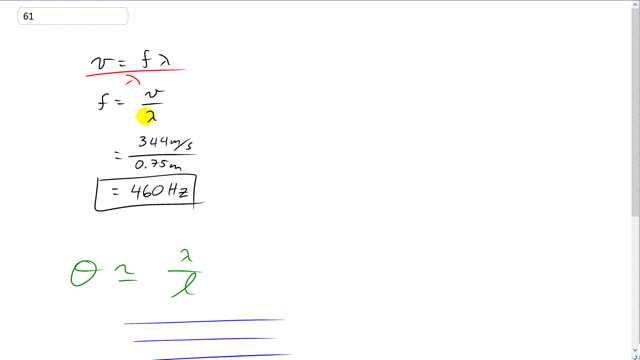
What frequency of sound would have a wavelength the same size as a 0.75-m-wide window? (The speed of sound is 344 m/s at .) What frequencies would diffract through the window?

In order to watch this solution you need to have a subscription.
This is Giancoli Answers with Mr. Dychko. Knowing that the wave speed equals frequency times wavelength. We can divide both sides by λ and solve for f. f is gonna be speed of sound divided by the width of the window which will be the wavelength of the sound. So, that's 344 meters per second divided by 0.75 meters which is 460 hertz. Now, here's our formula for diffraction which says that the angle of diffraction, the angular spread of the wave after it passes either through an opening or around a solid object it is equal to the wavelength divided by the size of the opening or the object. So, here we have a window. So, l is the width of the window, 0.75 meters, and to say that the fraction is only significant if wavelength is equal to the width of the window is to say that the angle is about 1 we'll consider an angle of 1 radian to be significant. Because, you know, if λ equals l then λ divided by l is 1. And just because one radian is hard to picture, I converted that into degrees here, and that's 57 degrees. So, if this angle of diffraction this angular spread to the sides of the window here exceed 57 degrees, then we consider the diffraction to be significant. And that would be true whenever this ratio is 1 or more. And that'll happen when the wavelength is equal to the window width or greater, and that'll happen for frequencies less than 460 hertz because as the wavelength gets bigger frequency gets smaller. So, the answer to the second part of the question is significant diffraction for... For f less than or equal to 460 hertz. There.